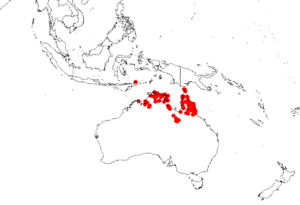Decaisnina brittenii facts for kids
Quick facts for kids Decaisnina brittenii |
|
|---|---|
| Scientific classification | |
| Genus: |
Decaisnina
|
| Species: |
brittenii
|
 |
|
| Occurrence data from AVH | |
| Synonyms | |
|
Amylotheca brittenii (Blakely) Danser |
|
Decaisnina brittenii is a special kind of flowering plant. It is an epiphytic hemiparasitic plant, which means it grows on other plants. It gets some of its food and water from its host plant. This plant is part of the Loranthaceae family. You can find it growing in the northern parts of Western Australia, the Northern Territory, and Queensland.
This plant looks very similar to another species called D. signata. The main way to tell them apart is by their leaves. Decaisnina brittenii has leaves that are long and narrow, like a spear. You will often find this plant growing on Melaleuca trees and Barringtonia trees.
How it Got its Name
Naming the Plant
The plant Decaisnina brittenii was first officially described in 1922. A botanist named William Blakely gave it the name Loranthus brittenii at that time. However, this plant had been seen much earlier.
In 1770, during Captain Cook's first voyage, a scientist named Joseph Banks collected a sample of this plant. This was at the Endeavour River. Later, Daniel Solander made a drawing of it for Joseph Banks.
Many years later, in 1966, another botanist, Bryan Alwyn Barlow, moved the plant to a different group. He decided it belonged in the genus Decaisnina.
What the Names Mean
The first part of the plant's name, Decaisnina, honors a French botanist. His name was Joseph Decaisne (1807–1882).
The second part of the name, brittenii, honors a British botanist. His name was James Britten (1846–1924).

